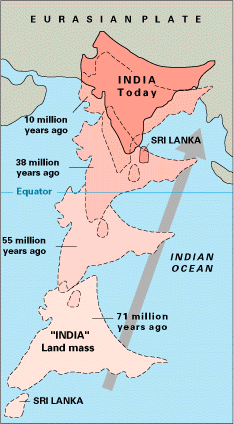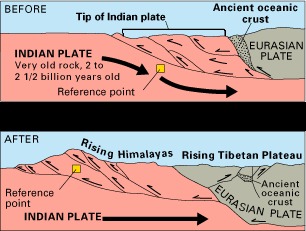MIT research: Indian Plate Collided with Asia later than previously thought
 |
| This map shows 15 of the largest plates. Note that the Indo-Australian Plate may be breaking apart into the Indian and Australian plates, which are shown separately on this map (wikipedia) |
|
|
| The Journey of Indian Plate - still continuing.... |
You might have heard of Plate Tectonics ( Wikipedia- Plate Tectonics) which says that the Earth's Lithosphere is broken in to various tectonic plates. On Earth, there are seven or eight major plates (depending on how they are defined) and many minor plates. Where plates meet, their relative motion determines the type of boundary: convergent, divergent, or transform. Earthquakes, volcanic activity, mountain-building, and oceanic trench formation occur along these plate boundaries. The lateral relative movement of the plates typically varies from zero to 100 mm annually. So in a normal course of human life of 100 years we see that maximum movement of plate will be 10 meters (which can be jumped in a go ) !!!
So such a small imperceivable moments go unnoticed to not only human senses but also to even sophisticated scientific instruments. So the concept of wandering continents took lot of time to evolve completely. The idea that the continents are not static and wander across started with Alfred Wegner somewhere in 1912. He struggled all his life to prove his hypothesis, but couldn't succeed. Later evidences like sea floor spreading, paleo-magnetism etc. paved way for development of plate tectonics theory.
Now the theory is widely accepted and origin of many landforms on the face of Earth are well explained by it. The movement of plates has caused the formation and break-up of continents over time, including occasional formation of a supercontinent that contains most or all of the continents. The supercontinent Columbia or Nuna formed during a period of 2,000 to 1,800 million years ago and broke up about 1,500 to 1,300 million years ago. The supercontinent Rodinia is thought to have formed about 1 billion years ago and to have embodied most or all of Earth's continents, and broken up into eight continents around 600 million years ago. The eight continents later re-assembled into another supercontinent called Pangaea; Pangaea broke up into Laurasia (which became North America and Eurasia) and Gondwana (which became the remaining continents).
The most majestic journey of the plates is the journey of Indian Plate. The India Plate or Indian Plate is a tectonic plate that was originally a part of the ancient continent of Gondwana from which it split off, eventually becoming a major plate. About 55 to 50 million years ago it fused with the adjacent Australian Plate. It is today part of the major Indo-Australian Plate, and includes most of South Asia – i.e., the Indian subcontinent – and a portion of the basin under the Indian Ocean, including parts of South China and Eastern Indonesia, and extending up to but not including Ladakh, Kohistan and Balochistan.
Most of the highest peaks of the world stand tall in the chain of The Himalayas. The peaks of the Himalayas are a modern remnant of massive tectonic forces that fused India with Asia tens of millions of years ago. The Himalayas believed to have into existence because of collision of Indian and Asian plates engulfing thethys sea and island arch in between. Previous estimates have suggested this collision occurred about 50 million years ago, as India, moving northward at a rapid pace, crushed up against Eurasia. The crumple zone between the two plates gave rise to the Himalayas, which today bear geologic traces of both India and Asia. Geologists have sought to characterize the rocks of the Himalayas in order to retrace one of the planet’s most dramatic tectonic collisions.
Now researchers at MIT have found that the collision between India and Asia occurred only 40 million years ago — 10 million years later than previously thought. The scientists analyzed the composition of rocks from two regions in the Himalayas, and discovered evidence of two separate collisional events: As India crept steadily northward, it first collided with a string of islands 50 million years ago, before plowing into the Eurasian continental plate 10 million years later.
Oliver Jagoutz, assistant professor of geology in MIT’s Department of Earth, Atmospheric and Planetary Sciences, says the results, which will be published in Earth and Planetary Science Letters, change the timeline for a well-known tectonic story.
Since 2000, Jagoutz has trekked to the northwest corner of the Himalayas, a region of Pakistan and India called the Kohistan-Ladakh Arc. This block of mountains is thought to have been a string of islands that was sandwiched between the two continents as they collided. His team has brought back three tons of rocks, which he and his colleagues analyzed for signature isotopes.
The researchers split the rocks, and separated out more than 3,000 zircons — 100 to 200 micron-long crystals containing isotopic ratios. Jagoutz and his colleagues first determined the age of each zircon using another isotopic system, in which uranium turns slowly to lead with time. The team then measured the ratios of strontium to neodymium, and lutetium to hafnium, to determine the presence of a collision, keeping track of where each zircon was originally found (along the region’s northern or southern border).
The team found a very clear signature: Rocks older than 50 million years contained exactly the same ratio of isotopes in both the northern and southern samples. However, Jagoutz found that rocks younger than 50 million years, along the southern boundary of the Kohistan-Ladakh Arc, suddenly exhibited a range of isotopic ratios, indicating a dramatic tectonic event. Along the arc’s northern boundary, the same sudden change in isotopes occurs, but only in rocks younger than 40 million years.
Comparing this with the Australian continental plate collision with a string of islands known as the Sunda Arc since two million years, it can be
concluded that : Fifty million years ago, India collided with a string of islands, pushing the island arc northward. Ten million years later, India
collided with the Eurasian plate, sandwiching the string of islands, now known as the Kohistan-Ladakh Arc, between the massive continents.
Peter Clift, a professor of petroleum geology at Louisiana State University, says it may take a while for his colleagues to embrace this new timeline
of collisional events.


